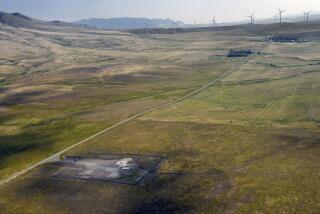Radar Tower Emissions Called Safe After Test : Ojai Valley: The daylong study fails to ease residents’ fears. The results are considered below the national standard.
- Share via
Surrounded by detailed charts and maps, National Weather Service officials on Friday pointed to the results of a daylong study of energy emissions from a Sulphur Mountain radar tower which they say prove the weather-tracking system is safe.
“We’re very confident that the microwave energy from the radar tower is way below the national standard,” said Jim Campbell, deputy director of the National Weather Service’s Western region.
Private researchers, hired by the National Weather Service, conducted six tests near the tower on Wednesday. Each one showed low levels of energy being emitted from the 98-foot radar tower, Campbell said.
The tests were conducted specifically to ease local residents’ fears of exposure to radiation.
Campbell said the national standard for microwave emissions, set by the American National Standards Institute, is 1.8 milliwatts per centimeters squared. The highest average emission--.0006--was recorded at a site on Sulphur Mountain Road.
“That’s 10,000 times below the national standard,” Campbell said, pointing to a graph behind him. Campbell said an emission of .0006 has the same effect as standing 10 feet from a microwave oven while it’s on.
Researchers tested emissions at five other sites: two others on Sulphur Mountain Road, one from the property where the tower stands, one from an upper Ojai elementary school and one from Santa Paula. Lower emissions were recorded at all five sites.
But residents said they weren’t worried about an average emission. They wanted to know the amount of radiation emitted during peak periods. The radar’s energy is emitted in pulses.
Robert Martin, one of two researchers from the Illinois Institute of Technology Research Institute who conducted the tests, said at their highest point, the peaks of energy measured between .01 and .1 milliwatts per centimeters squared.
“Overwhelmingly, the conclusions have been that this microwave energy emitted is safe for humans,” Campbell said, citing airport radar towers as an example of a system that has shown no harmful effects. “This has been looked at for over 30 years, there’s been something like 10,000 studies done . . . there would be some evidence that there is some increased risk and that hasn’t been shown.”
But Ojai Valley residents were not convinced by the recent test results or the government’s claims. They stand firm in their desire to have the tower moved.
“I don’t think it makes a difference,” Ojai Valley resident Lance Bergland said of the test results. “We don’t believe in the standard.”
Dale Givner said the residents will continue to fight the tower’s operation in the courtroom and in the legislature. The tower is operating at this time, while tests are being completed by the firm constructing 165 Doppler radar stations nationwide.
“We’re going to fight this in court,” Givner said. “If we had the money we’d do it immediately.”
He said residents are trying to raise money to appeal a federal judge’s decision earlier this month that allowed the government to turn on the radar tower. Givner estimates it could cost between $75,000 and $100,000 to appeal.
He said they are also trying to enlist local politicians to help them in their fight.
Last week Rep. Elton Gallegly (R-Simi Valley) introduced legislation to two congressional committees asking for the tower’s operation to be suspended while a 12-month study is conducted to look at potential heath risks.
Residents were pleased by Gallegly’s political move.
“We are going to push very hard to get that passed,” Bergland said.
More to Read
Sign up for Essential California
The most important California stories and recommendations in your inbox every morning.
You may occasionally receive promotional content from the Los Angeles Times.













